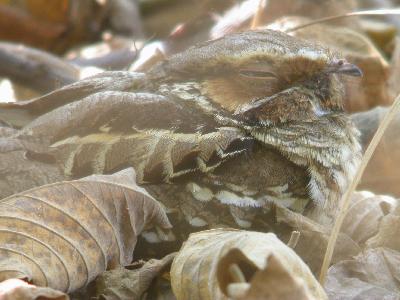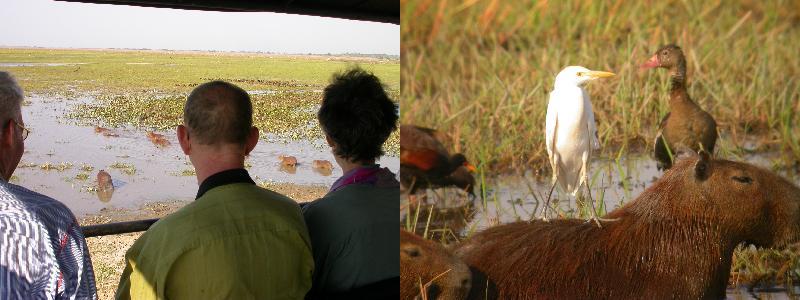
|
N-Venezuela Birding Trip
March 2005
Introduction
While it was very cold in Europe, March was a very hot and dry month in the north of Venezuela. This trip organised for Ecotourist Services of the Netherlands. 8 participants (as in January) joined.
It was a pity that not all participants were birders and that I didn't have a second guide.
Nevertheless, we had more than enough birds at the end of the trip: 486 species!
6 March: In the very dry scrub it was in a way a surprise to find here Crested Spinetails and also some Long-tailed Antbirds.
7 March: A quick stop in Rancho Grande. Flavescent Warbler walked on the path of the loop trail.
Towards the afternoon, we drove down to the coastal and drier scrub. It was a very hot and dry day. Very differenty from the past 2 trips.
There are plenty of good birding places here, so we made short stops at various sites.
The last stop is usually good for Glaucous Tanager. Some hadnít seen it yet. And it didnít take long or it was on everyones list.
A shy Upland Sandpiper surprised us.
8 March: The Choroni pass was very rewarding now. Mixed flock after mixed flock. Everyone saw all the specialities and even at close range. A Three-toed Sloth was hanging just behind our car.
The afternoon was a bit more relaxed. We birded mainly around the southern side. We were staring a long time to a few flowering trees with Brown Violet-ear, Golden-tailed Sapphire and many other.
9 March: In the morning we hung around the visitor centre. Noticed that many good species can be found here. We added Yellow-throated Vireo and Handsome Fruiteater.
10-12 March: Los Llanos is always a feast for nature lovers. So I decided to include an extra day in Hato El Frio.
Nobody regretted this, although most special birds were seen already after 2 days.
The extra day gave us some space for site activities as catching piranha's, and a night excursion.
We had an excellent time here, thanks to Rafael and Daniel, 2 Spanish students working on their thesis.
Perhaps services were quite bad in the past, but these times have long gone. In that respexct I do not agree with the vision of Mary Lou Goodwin in her "Birding in Venezuela". Personally I even think it is better than any other hato.
We left everyday at 7h30, besides we always had excellent meals and an excellent service.
We saw all the main species, such as several Orinoco Geese, Burrowing Owls, Band-tailed and Nacunda Nighthawks, White-tailed Nightjar, Pinnated Bittern, White-bearded Flycatchers and many Orinocan Saltators, just to name a few specialities.
Also we had lots of mammals: Giant Anteaters, a Southern Tamandua, Crab-eating Foxes, Amazon River Dolphins, Orinoco Crocodiles, White-tailed Deers and a Common Opossum.

13 March: We left just after the early breakfast. A stop was good for Amazonian Black-tyrant and Green-&-rufous Kingfisher.
14 March: About a month ago I discovered an interesting reserve in the foothills. With an interesting trail going through prime forest. So immediately I changed the itinerary and I included this into the program.
It didnít disappoint me. We saw Golden-headed Manakins, Spotted Nightingale-Thrush, Black-faced Antthrush, Tawny-throated Leaftosser and Plain Antvireo.
15 March: In the morning we visited a site in the lower foothills (Rio Barragan), where we saw Violaceous Jays and another couple of Pale-billed Jacamars.
On the next stop, we found an interesting fruiting tree, with female Golden-winged Manakins. Jan decided to wait a bit longer at this tree and he was rewarded with some male manakins.A Black Hawk-eagle few a few times over and so did a Saffron-headed Parrot. A nice bird that easy can be recognized even in flight with his bright yellow head. A bit later we saw a Chestnut-capped Brush-finch. This species is always a bit shy, but apparently not today.
Long-billed Gnatwren was a nice bird to finish the day.
16 March: In Las Tapias, a few lucky saw Merida Tapaculo, Yellow-bellied Chat-Tyrant.
In the afternoon we drove down to the Cock-of-the-Rock lek. It was very silent today apart from the Cocks, which were seen excellently.
In the evening we made another stop for Torrent Duck and now everyone could see perfectly male and female.
17 March: Paramo day. Ochre-browed Thistletail and Andean Tit-Spinetail were found easily.
18 March: We drove towards El Morro. It was ideal for the not so much walkers. The road goes through some excellent forest and also through some very dry habitat, where we always find Black-backed Grosbeaks. Best bird was the Golden-headed Quetzal.
19 March: The Pico Humboldt trail is one of the best birding trails in Venezuela. The trail is being used for trekkers who want to climb the highest mountains of Venezuela (Pico Humboldt and Pico Bolivar). In a way Iím very pleased about this as birds are getting used to people. Every year I notice that birds can be seen closer.
We started early as I expected a lot of climbers, but we didnít meet a lot during the day. About half-way a Chestnut-crowned Antpitta hopped on the trail. It continued hopping along the trail and Volkert could film the bird in excellent light.
It was an excellent day with other good birds as Yellow-bellied Chat-tyrant, Flavescent Flycatcher, White-browed Spinetail, Grey-capped and Oleaginous Hemispinguses.
At a certain moment I heard a Grey-naped Antpitta quite close and a short playback made him come very very close. I was glad that everyone had excellent views of this jewel. For those that joined, this was undoubdly the best bird of the whole trip.
On the way back we ran into some army ants. Army ants at this altitude are always accompanied by Slaty-backed Nightingale-thrushes. Also this time. Other birds that were present were Chestnut-capped Brush-finch and a Swainsonís Thrush.
20 March: La Carbonera. This winding road through cloud forest is always a surprise. Today the flocks werenít as active as normal. But some saw the Ornate Hawk-eagle sitting on a distant branch.
21 March: We made a stop in the foothill place.
The main bird is here the localised Citron-throated Toucan, which was common today. As well as the other toucans: Collared Aracari and Black-mandibled Toucan.
Bronze-winged Parrot flew over.
Black-faced Antthrushes, a different (sub-)species from the ones in Henri Pittier, called from the dense tangled undergrowth.
We walked all the way till the river, .
Little Cuckoo, Fasciated Tiger-Heron.
22 March: A morning stop in another foothill place us Red-lored Parrot. Formerly unknown in the Venezuelan Andes, but apparently a population has settled.
We took a boat in Puerto Cocha for a trip in the Catatumbo. At the start a Black Caracara welcomed us. The trip produced us several Northern Screamers who flew from the floating vegetation into nearby trees, where everyone could see them very well.
23 March: Left early for a long drive towards Maracaibo. A quick stop for Pygmy Swifts. And then on to Misoa, where Gustavo joined us.
Most remarkable was here the Toucan. Was it a Channel-billed, a Citron-throated or something in between? In the afternoon we drove through very dry scrub, when it suddenly started to rain! Bizarre, after being a month without rain in the rain forests! Not for long though. When we arrived it was powderdry. Still it was ďrelativeĒ cool, but not too hot, due to the clouds. We found fairly quickly all specialities: Maracaibo Tody-flycatcher, Northern Scrub-Flycatcher, Slender-billed Inezia, White-whiskered Spinetail, Orinocan Saltator, Glaucous Tanager, Ferruginous Pygmy-owl, with the exception of Chestnut Piculet.
24 March: Day Trip to the Perija foothills.
A nice but very hot day. We walked in the forest even over a bitumen trail! Natural made due to an eruption of oil! We found Lance-tailed Manakin (seen much better), Moustached Puffbird, Black-headed Tody-flycatcher, Red-crowned Ant-tanager and Long-billed Gnatwren. But best birds were a couple of Royal Flycatchers. The male was displaying nearby to a female. Unfortunately he didn't raise his crest fully.
25 March: Campo Boscan
Campo Boscan is a bit the Llanos of the north. Lots of herons, ducks and other waders. But still with some different birds, such as the Northern Screamers, Carib Horneros, Red-&-Green Macaws.
In a nearby tree a White-naped Xenopsaris was calling.
We ended the trip with a quick visit to coastal lagoons and mangroves. Seeing all the sea- and shore-birds was in a way a small adaptation allready to Holland.
With the exception of the flamingos (although) and the mangrove species. We could add a Mangrove Warbler as a last souvenir.